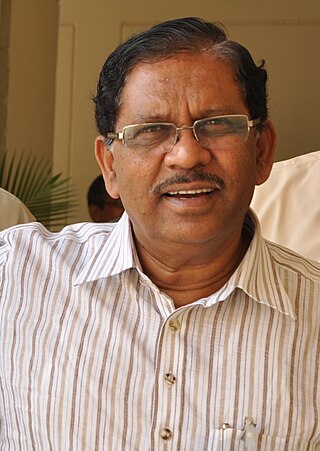Related Research Articles

University of Agricultural Sciences, Bangalore is located in Bengaluru, India. It was established in 1964 as UAS Bangalore by a legislative act.
The Birdwatchers' Field Club of Bangalore is a birdwatching club in Bangalore founded in the 1970s.

Krishna Raja Sagara, also popularly known as KRS, is a lake and the dam that creates it. They are close to the settlement of Krishna Raja Sagara in the Indian State of Karnataka. The gravity dam made of surki mortar is below the confluence of river Kaveri with its tributaries Hemavati and Lakshmana Tirtha, in the district of Mandya.

Lalbagh Botanical Garden or simply Lalbagh, is a botanical garden in Bangalore, India, with an over 200-year history. First planned and laid out during the dalavaiship of King Hyder Ali, the garden was later managed under numerous British Superintendents before Indian Independence. It was responsible for the introduction and propagation of numerous ornamental plants as well as those of economic value. It also served a social function as a park and recreational space, with a central glass house dating from 1890 which was used for flower shows. In modern times, it hosts two flower shows coinciding with the week of Republic Day and Independence Day. As an urban green space along with Cubbon Park, it is also home to numerous wild species of birds and other wildlife. The garden also has a lake adjoining a large rock on which a watchtower had been constructed during the reign of Kempegowda II.

Kempe Gowda I locally venerated as Nadaprabhu Kempe Gowda, or commonly known as Kempe Gowda, was a governor under the Vijayanagara Empire in early-modern India. He is famous for the development of Bangalore Town in the 16th century. Kempegowda erected many Kannada inscriptions across the region.

Bengaluru is the capital city of the state of Karnataka. Bengaluru, as a city, was founded by Kempe Gowda I, who built a mud fort at the site in 1537. But the earliest evidence for the existence of a place called Bengaluru dates back to c. 890.
Bengaluru is the capital and the largest city of the Indian state of Karnataka. It is India's third largest city and fifth largest metropolitan area. Modern Bengaluru was founded in 1537 CE by Kempe Gowda, a vassal of the Vijayanagara Empire. Kempe Gowda built a mud fort in the vicinity of modern Bengaluru. By 1831, the city was incorporated into the British Raj with the establishment of the Bangalore Cantonment. The British returned dominion of the city to the King of Mysore, choosing however, to retain jurisdiction over the cantonment. Therefore, Bengaluru essentially became a twin city, with civic and infrastructural developments of the cantonment conforming to European styles of planning.
Bengaluru is the capital and largest city of the Indian state of Karnataka. With a population of over 15 million, Bengaluru is the third largest city in India and 27th largest city in the world. Bengaluru is one of the most ethnically diverse cities in the country, with over 51% of the city's population being migrants from other parts of India. Historically a multicultural city, Bengaluru has experienced a dramatic social and cultural change with the advent of the liberalization and expansion of the information technology and business process outsourcing industries in India. IT companies in Bangalore employ over 35% of India's pool of 1 million IT professionals.

Rai Bahadur and Rao Bahadur, abbreviatedR.B., was a title of honour bestowed during British rule in India to individuals for outstanding service or acts of public welfare to the Empire. From 1911, the title was accompanied by a medal called a Title Badge. Translated, Rai or Rao means "King", and Bahadur means "Brave". Bestowed mainly on Hindus, the equivalent title for Muslim and Parsi subjects was Khan Bahadur. For Sikhs it was Sardar Bahadur.
M. H.. Marigowda(Maragowdanahalli Hombegowda marigowda) is also known as Father of Horticulture in Karnataka.

Bugle Rock is a massive rock in the Basavanagudi area of South Bangalore, in the state of Karnataka. It is an abrupt rise above the ground of peninsular gneiss as the main rock formation and with an assessed age of about 3,000 million years. Bugle Rock has generated wide interest among the scientific community.

The central business district of Bangalore is the area within a 6 km radius around Vidhan Soudha. This is the center of Bangalore and was founded by Kempegowda of the Vijayanagara Empire. Most of the land is used by commercial establishments and the Indian Army with plans of skyscrapers under works. It has multiple high-rises including World Trade Center Bangalore and UB Tower. It also includes heritage properties like the Bangalore Fort and the Bangalore Pete.

Gustav Hermann Krumbiegel was a German botanist and garden designer who was best known for his work at the Lal Bagh Botanical Gardens in Bangalore and for the planning of the avenues of Bangalore. He also established the first horticultural training school in India.
There is a small community of Germans in India consisting largely of expatriate professionals from Germany and their families as well as international students at Indian universities.
Jayachamarajendra Road, or simply J.C. Road, is a street in the heart of Bangalore, the state capital of Karnataka, India, named after Maharaja Jayachamaraja Wadiyar. It is located in Kalasipalya and connects with Kasturba Road to the north. The road houses many important landmarks of the city such as the BBMP Head Office, Bangalore Town Hall, and Ravindra Kalakshetra; is also lies in close proximity to the Lal Bagh Botanical Gardens. Sri Bhagawan Mahaveer Jain College lies along the road.

GangadharaiahParameshwara is an Indian politician who is currently serving as the Home Minister of Karnataka since 27 May 2023. He has also served as the seventh Deputy Chief Minister of Karnataka, and longest-serving President of the Karnataka Pradesh Congress Committee for two consecutive terms.

The Indian Institute of Horticultural Research (IIHR) is an autonomous organization acting as a nodal agency for basic, strategic, anticipatory and applied research on various aspects of horticulture such as fruits, vegetable, ornamental, medicinal and aromatic plants and mushrooms in India. The institute has its headquarters in Bengaluru, Karnataka, India and is a subsidiary of Indian Council of Agricultural Research (ICAR), New Delhi, under the Ministry of Agriculture, India. It recently has been ranked 1st for the combined years 2019-20 and 2020–21 by the ICAR.

Bengaluru, formerly called Bangalore in English, is the capital and largest city of the southern Indian state of Karnataka. It has a population of more than 8 million and a metropolitan population of around 15 million, making it India's third most populous city and fourth most populous urban agglomeration. It is the most populous city and largest urban agglomeration in South India, and is the 27th largest city in the world. Located on the Deccan Plateau, at a height of over 900 m (3,000 ft) above sea level, Bengaluru has a pleasant climate throughout the year, with its parks and green spaces earning it the reputation of India's "Garden City". Its elevation is the highest of India's major cities.
Krishna Lal Chadha is an Indian horticultural scientist, author and a former National Professor of the Indian Council of Agricultural Research. He was honored by the Government of India, in 2012, with the fourth highest Indian civilian award of Padma Shri.

College of Horticulture Mudigere is a horticulture college located in Mudigere, Karnataka, India. Established in 1991, it is affiliated to the University of Agricultural and Horticultural Sciences, Shivamogga and was previously affiliated to the University of Horticultural Sciences, Bagalkot. This horticultural education center is the oldest in Karnataka. The college has been accredited by the Indian Council of Agricultural Research since 25 August 2004.
References
- ↑ "Biography of H C Javaraya to be launched today". Deccan Herald. 14 April 2023. Retrieved 14 April 2023.
- ↑ "Remembering the man who enhanced Bengaluru's green cover". The Times of India. 15 April 2023. Retrieved 15 April 2023.
- ↑ A Gardener and A Gentleman (First ed.). Bengaluru: Kewgarth Group. 2023. p. 28.
- 1 2 3 A Gardener and A Gentleman (First ed.). Bengaluru: Kewgarth Group. 2023. p. 29.
- 1 2 3 4 5 6 7 8 9 "HC Javaraya, eminent Karnataka horticulturist whose apple cultivation technique is still used in Switzerland". South First. 15 April 2023. Retrieved 15 April 2023.
- ↑ "Javaraya, the man who changed the face of Bengaluru's famed Lalbagh". The Economic Times. 14 April 2023. Retrieved 14 April 2023.